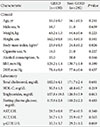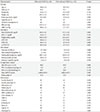1. Bytzer P, Talley NJ, Leemon M, Young LJ, Jones MP, Horowitz M. Prevalence of gastrointestinal symptoms associated with diabetes mellitus: a population-based survey of 15,000 adults. Arch Intern Med. 2001; 161:1989–1996.
2. Revicki DA, Wood M, Maton PN, Sorensen S. The impact of gastroesophageal reflux disease on health-related quality of life. Am J Med. 1998; 104:252–258.
3. Wahlqvist P. Symptoms of gastroesophageal reflux disease, perceived productivity, and health-related quality of life. Am J Gastroenterol. 2001; 96:8 Suppl. S57–S61.
4. Vakil N, van Zanten SV, Kahrilas P, Dent J, Jones R. Global Consensus Group. The Montreal definition and classification of gastroesophageal reflux disease: a global evidence-based consensus. Am J Gastroenterol. 2006; 101:1900–1920.
5. Dent J, El-Serag HB, Wallander MA, Johansson S. Epidemiology of gastro-oesophageal reflux disease: a systematic review. Gut. 2005; 54:710–717.
6. Wong BC, Kinoshita Y. Systematic review on epidemiology of gastroesophageal reflux disease in Asia. Clin Gastroenterol Hepatol. 2006; 4:398–407.
7. Park KH, Yoon SB, Jo MH, Hong EK, Lee SJ, Jeong IK, Park CY, Oh KW, Kim HK, Yu JM, Kim DM, Lim SH, Choi MK, Yoo HJ, Park SW, Oh HY, Kim JB, Baek IH, Lee MS. Clinical characteristics and analysis of risk factor for gastroesophageal reflux disease in diabetic patient. J Korean Diabetes Assoc. 2005; 29:358–366.
8. Bytzer P, Talley NJ, Hammer J, Young LJ, Jones MP, Horowitz M. GI symptoms in diabetes mellitus are associated with both poor glycemic control and diabetic complications. Am J Gastroenterol. 2002; 97:604–611.
9. Wang X, Pitchumoni CS, Chandrarana K, Shah N. Increased prevalence of symptoms of gastroesophageal reflux diseases in type 2 diabetics with neuropathy. World J Gastroenterol. 2008; 14:709–712.
10. Kase H, Hattori Y, Sato N, Banba N, Kasai K. Symptoms of gastroesophageal reflux in diabetes patients. Diabetes Res Clin Pract. 2008; 79:e6–e7.
11. Nishida T, Tsuji S, Tsujii M, Arimitsu S, Sato T, Haruna Y, Miyamoto T, Kanda T, Kawano S, Hori M. Gastroesophageal reflux disease related to diabetes: analysis of 241 cases with type 2 diabetes mellitus. J Gastroenterol Hepatol. 2004; 19:258–265.
12. Lluch I, Ascaso JF, Mora F, Minguez M, Pena A, Hernandez A, Benages A. Gastroesophageal reflux in diabetes mellitus. Am J Gastroenterol. 1999; 94:919–924.
13. Lundell LR, Dent J, Bennett JR, Blum AL, Armstrong D, Galmiche JP, Johnson F, Hongo M, Richter JE, Spechler SJ, Tytgat GN, Wallin L. Endoscopic assessment of oesophagitis: clinical and functional correlates and further validation of the Los Angeles classification. Gut. 1999; 45:172–180.
14. Kusano M, Shimoyama Y, Sugimoto S, Kawamura O, Maeda M, Minashi K, Kuribayashi S, Higuchi T, Zai H, Ino K, Horikoshi T, Sugiyama T, Toki M, Ohwada T, Mori M. Development and evaluation of FSSG: frequency scale for the symptoms of GERD. J Gastroenterol. 2004; 39:888–891.
15. Ha BK, Kim BG, Kim DH, Lee SI, Jung SM, Park JY, Lee CW, Kim SS, Kim BH, Kim IJ. Relationships between brachial-ankle pulse wave velocity and peripheral neuropathy in type 2 diabetes. Diabetes Metab J. 2012; 36:443–451.
16. Bae YP, Yi BD, Kim BG, Park JH, Kwon YS, Park JY, Lee CW, Kim BH, Jang JS. Relationships between cardiac autonomic neuropathy and the brachial-ankle pulse wave velocity in patients with type 2 diabetes. Endocrinol Metab. 2011; 26:44–52.
17. Lee SH, Choi MG, Park SH, Choi H, Moon SB, Choo KY, Wang JH, Kim JK, Choi KY, Chung KW, Sun HS. The clinical spectrum of gastroesophagel reflux disease in Korea. Korean J Gastrointest Motil. 2000; 6:1–10.
18. Richter JE. Diagnostic tests for gastroesophageal reflux disease. Am J Med Sci. 2003; 326:300–308.
19. Cho YS, Choi MG, Jeong JJ, Chung WC, Lee IS, Kim SW, Han SW, Choi KY, Chung IS. Prevalence and clinical spectrum of gastroesophageal reflux: a population-based study in Asan-si, Korea. Am J Gastroenterol. 2005; 100:747–753.
20. Jeong JJ, Choi MG, Cho YS, Lee SG, Oh JH, Park JM, Cho YK, Lee IS, Kim SW, Han SW, Choi KY, Chung IS. Chronic gastrointestinal symptoms and quality of life in the Korean population. World J Gastroenterol. 2008; 14:6388–6394.
21. Sun XM, Tan JC, Zhu Y, Lin L. Association between diabetes mellitus and gastroesophageal reflux disease: a meta-analysis. World J Gastroenterol. 2015; 21:3085–3092.
22. Hirata A, Kishida K, Nakatsuji H, Inoue K, Hiuge-Shimizu A, Funahashi T, Shimomura I. High prevalence of gastroesophageal reflux symptoms in type 2 diabetics with hypoadiponectinemia and metabolic syndrome. Nutr Metab (Lond). 2012; 9:4.
23. El-Serag HB, Graham DY, Satia JA, Rabeneck L. Obesity is an independent risk factor for GERD symptoms and erosive esophagitis. Am J Gastroenterol. 2005; 100:1243–1250.
24. Nilsson M, Johnsen R, Ye W, Hveem K, Lagergren J. Obesity and estrogen as risk factors for gastroesophageal reflux symptoms. JAMA. 2003; 290:66–72.
25. Lee SD, Keum B, Chun HJ, Bak YT. Gastroesophageal reflux disease in type II diabetes mellitus with or without peripheral neuropathy. J Neurogastroenterol Motil. 2011; 17:274–278.
26. Feldman M, Sleisenger MH, Friedman LS. Chapter 33, Gastroesophageal reflux disease and its
complications, including Barrett's metaplasia. Sleisenger & Fordtran's gastrointestinal and liver disease: pathophysiology, diagnosis, management. 7th ed. Philadelphia: W.B. Saunders;2002. p. 599–622.
27. National Health Insurance Corporation. 2009 National health screening statistical yearbook. Seoul: National Health Insurance Corporation;2010.
28. Kwak MS, Park EC, Bang JY, Sung NY, Lee JY, Choi KS. Factors associated with cancer screening participation, Korea. J Prev Med Public Health. 2005; 38:473–481.









 PDF
PDF ePub
ePub Citation
Citation Print
Print



 XML Download
XML Download